Overview
Ground cover plant is any plant that grows and spread quickly over an area of ground to form a dense cover. Ground cover plants are used to fill in gaps at the front of a border, as well as those tricky spots at the bases of shrubs that are difficult to plant. Ground cover plants are also great for covering tricky sites, such as slopes, which are difficult to access and plant. Some can also be grown as an alternative to a lawn.
Ground cover plants provide protection of the topsoil from erosion and drought. In an ecosystem, the ground cover forms the layer of vegetation below the shrub layer known as the herbaceous layer. The term ground cover can also specifically refer to landscaping fabric which is like a breathable tarp that allows water and gas exchange.
There are hundreds of ground cover plants that can be grown for their evergreen foliage of flowers and sometimes both. Below are some of the gorgeous ground cover plants.
1. Trailing acacia (Acacia redolens)
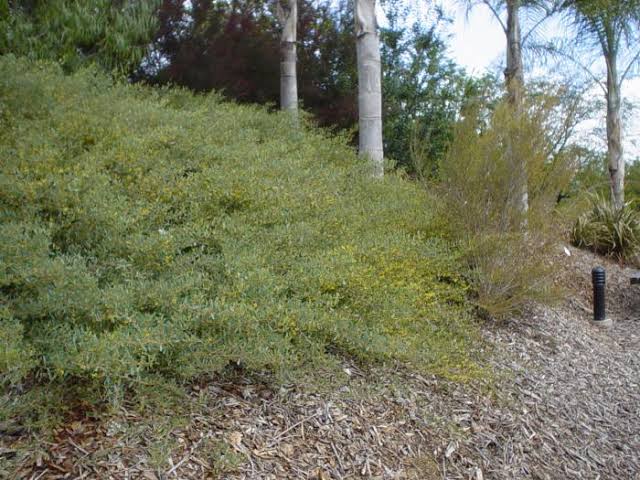
Native to Australia, trailing acacia is a low growing and wide spreading ground cover. It grows to about 1 foot tall and can spread to 12 feet across. The leathery leaves are actually the modified petiole of a “true” leaf and are dark olive-green in color. The leaves remain through cold or drought conditions.
In the spring, this plant is adorned with small, yellow flowers. Several trailing acacia plants may be grouped to create a continuous ground cover on banks or slopes for excellent, natural erosion control.
Although trailing acacia is quite drought resistant, it also tolerates periodic flooding, and a number of landscape architects have used it successfully in retention basins.
This plant requires regular irrigation during the hot summer months. Place trailing acacia in full sun, as it tends to get rangy in the shade. Also, avoid planting it too close to walkways or other plants to prevent the need for frequent pruning.
2. Baby Sun Rose (Aptenia cordifolia)

This sprawling plant forms a dense mat that grows in flat clumps along the ground from six to twelve inches tall. It has bright green, heart-shaped, succulent leaves and small, reddish-purple to pinkish-purple, button-like flowers with yellow centers. Its flowers bloom from early spring until summer. The blossoms attract bees, opening during the daylight hours and closing at night. The variety ‘Red Apple’ has bright red flowers. This variety is a much faster and more vigorous growing plant.
Use it as a bank cover, along a retaining wall, in containers, rock gardens, or hanging baskets, cascading down a wall, or around boulders. It looks nice when used on the north sides of buildings or in north-facing planters. The hearts and flowers plant is native to the eastern coastal regions of South Africa.
The hearts and flowers prefer a well-draining, rich, sandy, or loamy soils and partial shade to filtered sun. It also tolerates drought conditions, but prefers regular irrigation, especially during the hot summer months.
This plant is relatively easy to propagate from cuttings and spreads vegetatively by rooting from its branches. It is hardy to twenty-three degrees Fahrenheit. Lightly fertilize it two to three times each year with ammonium phosphate to keep it looking healthy.
Also Read: Different Types of Fern Plants
3. Asparagus Fern (Asparagus densiflorus ‘Sprengeri’)
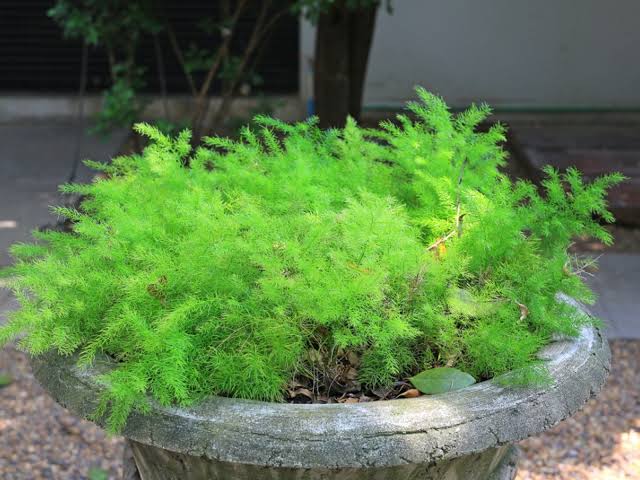
Asparagus fern is a mounding, spreading, evergreen that grows one to two feet with a three-foot spread. It is a fast-growing plant with bright green to yellow green, airy, fernlike, delicate leaves, and tiny thorns. It’s arching stems and branches cascade and trail, making this a great groundcover to use in the landscape.
In spring, it produces small, waxy, white, inconspicuous flowers that bloom sporadically. After flowering, small clusters of red berries appear that are toxic to humans, but are eaten by birds and rodents.
Use the plant as an understory plant, in coastal areas, containers, planters, and hanging pots with its foliage spilling over the sides, or cascading over rocks, boulders, or embankments. Also, plant it as an informal groundcover in tropical landscapes and around pools, water features, and fountains.
This is a great filler plant to use for a splash of green, lush foliage. Asparagus fern is very hard to remove because it produces underground tubers and has an extensive root system. This plant can be invasive in some locations, but is a tough, pest-free groundcover that is very easy to grow. It is native to South Africa.
4. Desert Marigold (Baileya multiradiata)
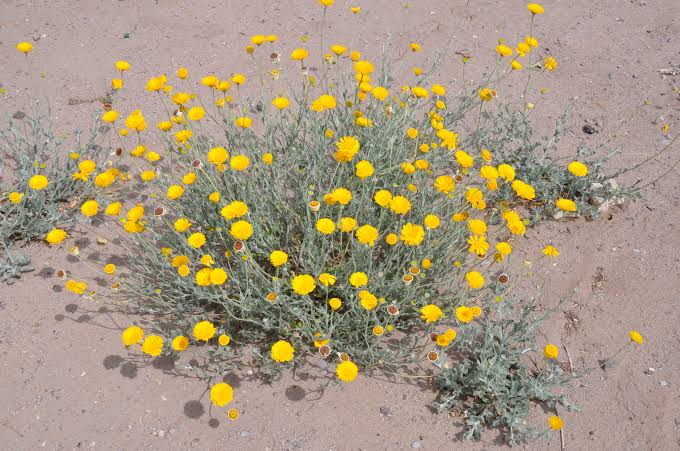
Desert marigold grows twelve inches tall and wide with fuzzy greenish-gray leaves and a compact, mounded shape. While a short-lived plant, it beautifies the landscape by producing bright yellow, daisy-like blossoms that grow on long stems.
The plant blooms through the early spring and into the summer months, and may intermittently bloom all year, except during the cold weather. Cut flowers can last for a long time, and a large amount of seed is present in the flower heads; collect the seeds when the flowers fade, and allow seeds to dry. This plant can also take hold and germinate in disturbed areas along roadsides.
Use the plant as a summer color or re-vegetation plant, in containers, or in desert rock gardens with cacti to add a touch of color to an area. It is a good companion plant to verbena and penstemon.
The plant is native to the Southwest and into northern Mexico, where it grows on desert plains, mesas, and rocky slopes at elevations below 5,000 feet.
Also Read: Types of Sage Plants
5. Shrubby Bulbine (Bulbine frutescens)
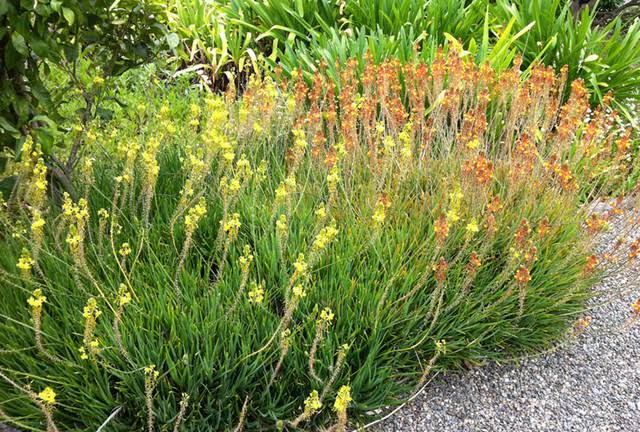
The succulent evergreen with fleshy, smooth, aloe-like green leaves is low-maintenance and easy to grow. It spreads by underground rhizomes, creating clumps of growth that reach heights of eighteen inches and spreads of three feet across.
In the fall through spring, it produces delicate, six-petaled, star-shaped, yellow flower spikes that grow twelve to eighteen inches above the plant, towards the sky. The variety ‘Hallmark’ produces orange blossoms. Bees and butterflies are attracted to the blooms. The fruit is a small, rounded capsule containing many black seeds that disperses in the wind when the fruit dries out.
In addition to its landscape value, the plant is cultivated in some parts of the world for it medicinal properties. The sap inside the leaves is used to treat chapped lips, insect bites, bee stings, sunburn, and other skin disorders. A tea can be made from the leaves to treat coughs, colds, and arthritis.
This fast-growing plant is hardy to about twenty degrees Fahrenheit. It may suffer some leaf damage in a hard frost, but recovers quickly in the spring. It is drought-resistant and can withstand long periods without water. It grows moderately and likes supplemental irrigation during the hot, dry season.
6. Hartweg Evening Primrose (Calylophus hartwegii subsp. Fendleri)

This fast-growing, bushy, perennial with linear, green foliage and showy flowers grows one foot high and two inches wide. During the spring and early summer, it develops small, yellow, buttercup-like blossoms. The flowers are present for only one day, but the plant continues to produce new blooms; the blooms open at night and start to fade by the next day.
It grows best in well-draining soil and is hardy to twenty degrees Fahrenheit or lower. The calylophus may die back during the winter, but re-sprouts quickly it early spring. During winter months, the foliage may turn dull in color or fall from the plant. It is native to the hillsides, valleys, roadways, plains, and open woods in Wyoming, Nebraska, Arizona, Texas, and Mexico.
7. Common ice Plant (Carpobrotus chilensis)

The succulent evergreen with brilliant blooms has three-sided leaves that form a thick, fleshy green mat. The common ice plant grows six inches to one foot, spreading three feet through an aggressive rooting system. Its bold foliage and warm season color makes it a great choice as a groundcover.
The common ice plant produces small, aster-like flowers in shades of red, pink, purple, or magenta, depending on the variety. The blossoms are showy from early summer into the fall. Its flowers are sterile and do not produce any seed.
Use it in sunny gardens, train it to trail down a vertical wall, or plant it in rock gardens or around pools and water features. The common ice plant can also be used in heavily eroded areas to root into the soil as a bank cover. It is an excellent choice for beachfront landscapes because it tolerates salty conditions. Rabbits may eat the plant, so when it is young, place chicken wire for protection.
The ice plant is native to the Pacific coastline from Oregon down to Baja California, as well as in Chile and South Africa. It species name, Chilensis, comes from the Latin name for Chile. The plant can become highly invasive in some areas.
Also Read: Different Types of Lantana Plant
8. Damianita (Chrysactinia Mexicana)
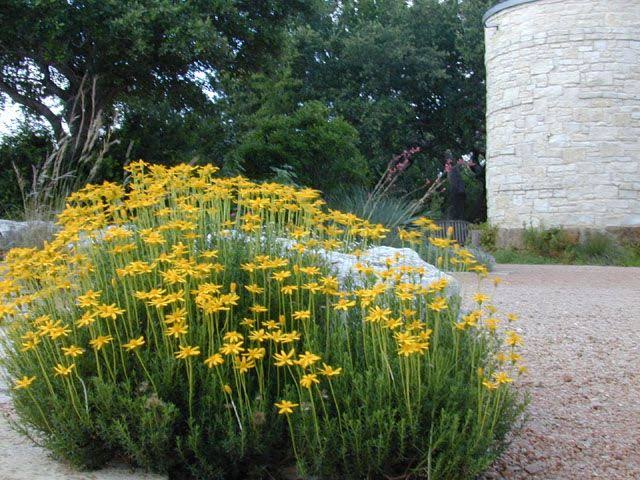
Native to western Texas and Mexico, Damianita is a star performer in the arid Southwest. The bright green, needlelike leaves create a nice contrast to the flowers that bloom much of the year. This plant has a long bloom period, but flowers are most profuse in the spring and fall. The bright green, finely textured foliage is fragrant. Grows slowly to 2 feet high and 2 feet wide. Golden yellow, daisylike flowers are small — about half an inch across. An ideal ground cover plant for Tucson and Southern Arizona, Damianita is tolerant of heat, drought and cold.
Damianita requires very little water, once it is established. This highly adaptable ground cover plant is both drought-tolerant and cold hardy. Damianita does best in full sun and in soil with good drainage. Group individual plants together to form a continuous ground cover.
9. Lemon Dalea (Dalea capitata)
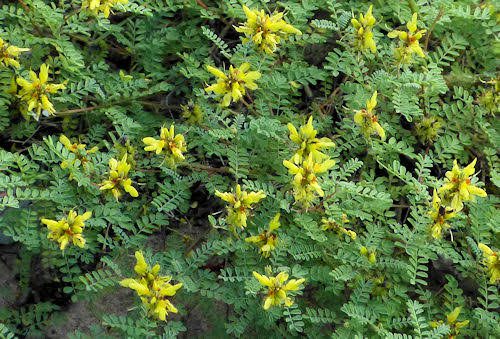
The sprawling, aromatic plant grows eight inches tall and three feet wide with lush, fine-textured, light green foliage and small, yellow flowers. It is fast-growing and forms a mound of dense foliage that makes it a great plant for many locations. The foliage and flowers have a lemony fragrance. Small, pea-like, yellow flowers appear on short spikes in spring and fall and attract bees and butterflies.
Use along walkways and street medians, in planters, as a groundcover tucked into large boulders, or in small, narrow spaces for a lush splash of green. This plant looks great when mixed with agave or tall yucca plants. It also works well around fountains, ponds, and water features. It is native to Coahuila, Mexico.
10. Creeping Dalea (Dalea greggii)
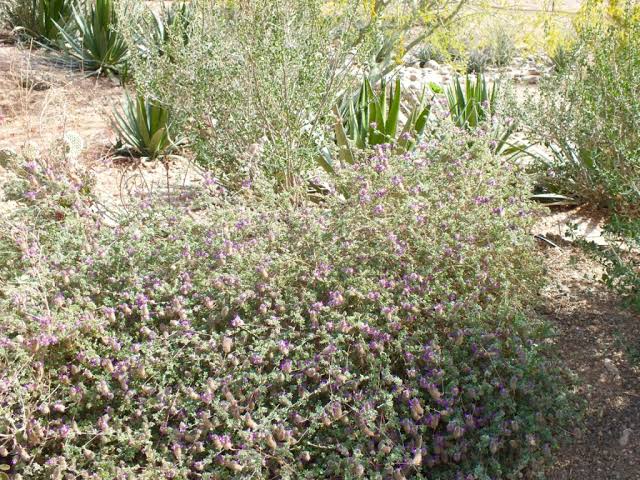
Creeping Dalea, also known as “Trailing Indigo Bush,” is an attractive, low-growing perennial with small silvery-gray leaves. Although solitary plants can be grown, Dalea greggii is often used in groupings as a ground cover. There are many fine stems on each plant that cascade from the center and root along the ground as they grow. Over time, these rooted stems create a dense mat that completely covers the surface of the soil.
Creeping dalea forms 4-foot wide mounds that reach a maximum height of 2 feet. In low desert regions, its silvery foliage is persistent through the winter providing year-round interest and color. In spring, dense clusters of small indigo to purple colored flowers bloom on creeping dalea and persist into the summer.
Also Read: Different Types of Jasmine VIne
11. Ice Plant (Drosanthemum speciosum ‘rosea’)
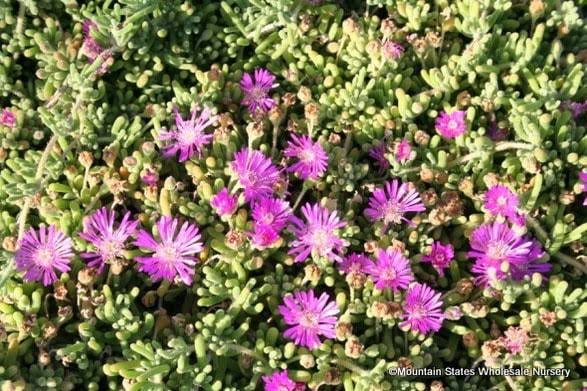
Ice Plant mixes well with other desert-adapted plants either as a filler in containers or as a ground cover. It forms a dense mat of sparkling leaves and brilliant colored flowers. The small, pill-shaped leaves have tiny glands that secrete salt crystals that gleam like ice crystals in the sunlight. Ice plants typically stay under 1 foot tall and spread in 3-foot clumps. Pinkish-purple flowers cover the ‘rosea’ variety from mid-spring to summer creating a blanket of intense color.
Its fast growth rate and spreading habit is best suited for barren spots in the yard and in areas with minimal traffic. Ice Plant also makes an excellent filler in containers or planters providing a brilliant splash of color to patios, retaining walls, seating areas or around a pool.
12. Blanket Flower (Gaillaridia x grandiflora)

The perennial continuous-flowering, rounded plant grows two to three feet tall from a taproot and spreads by underground rhizomes. It produces striking flowers and linear, dark green leaves that are serrated with coarse, grayish-white hairs. If the upper stems of the plant are destroyed, the plant re-grows from its rhizomes. It is a member of the sunflower family, developing large, brilliant, daisy-like flowers in colors of gold, red, orange, or bronze.
Many varieties are available, including shorter dwarf forms and various flower colors. Blooms last over a long period from early spring into the fall and attract butterflies and birds. Wild birds feed on the flower seeds, dispersing them to other parts of the landscape.
Use it in beds, borders, raised planters, perennial gardens, and low-water-use landscapes. The gaillardia also makes a beautiful cut flower for indoor arrangements. Its brilliant red and yellow colors add a great addition to any garden. Plant the blanket flower from seed or nursery transplants. It is a hybrid created by crossing North American wildflowers.
13. Gazania (Gazania rigens)

The gazania has a compact, mounding growth habit and produces beautiful flowers and dark blue or green dandelion-like leaves that grow one foot high and wide. In spring, large, daisy-like blooms appear that come in a variety of colors: red, orange, bright yellow, and bronzy yellow. The flowers attract bees, butterflies, and hummingbirds.
There are many different hybrids available. The flowers close at night and reopen during the day. This plant blooms prolifically in spring and again in fall. While beautiful, this short-lived species should be replanted every few years.
Also Read: Types of Snake Plant
14. Peruvian Verbena (Glandularia peruviana)
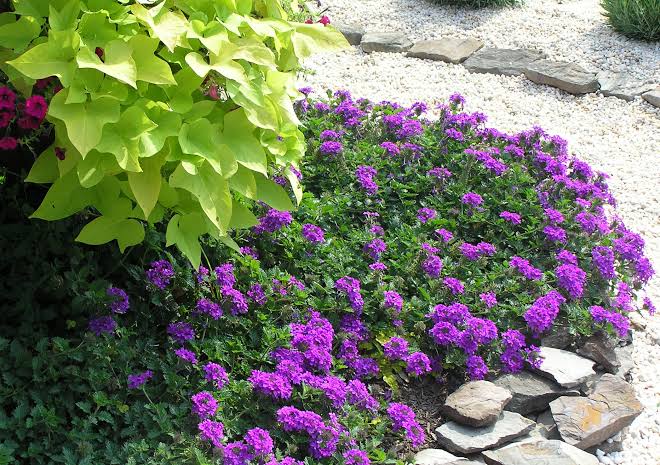
The fast-growing groundcover with its colorful flowers reaches six inches or taller, with a three- to six-foot spread. It trails and spreads along the ground, producing new herbaceous roots as it grows to form a dense mat. It has finely cut and lightly serrated deep green foliage. The Peruvian verbena produces tiny clusters of colorful flowers on its terminal ends in fuchsia, pink, red, white, or purple, depending upon one of the many varieties available.
Flowers appear in early spring, taper off during the summer, and then bloom again in the fall, attracting butterflies and bees. Use it as a transitional plant, in rock gardens, cascading over containers, or in low planters. It combines nicely with wildflowers and other perennial groundcovers. The Peruvian verbena is a great choice for low-water-use landscapes. This plant is native to South Africa where it grows at elevations of 800 to 2,500 feet.
15. Algerian Ivy (Hedera canariensis)
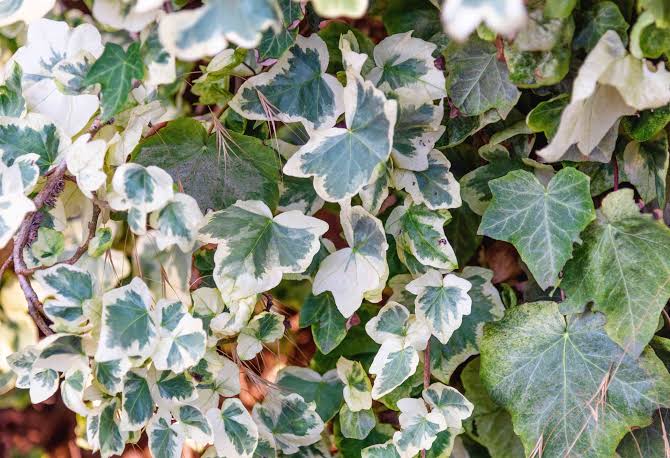
This fast-growing evergreen has thick, shiny, deep green, lobed leaves with reddish stems. New growth is a light green color. It rarely produces flowers, but if it does, they are whitish green in color. Algerian ivy can take over an area very quickly, making this plant an appealing groundcover. It likes well-draining soil with amendments, but will grow in most soil conditions.
Algerian ivy can also be used in coastal situations since it is very salt-tolerant. The variety ‘Variegata’ has green, lobed foliage surrounded by white and is less hardy than the green variety. There are many cultivars available of this plant.
Use it for its bold foliage in tropical settings, or plant it beneath deciduous trees, in shady areas of the landscape and in raised planters under covered patios. It can also be trained as a self-climbing vine in shady locations or northern exposures. Algerian ivy is native to northwestern Africa and the Canary Islands and is widely cultivated in warm, tropical areas of the world.
Also Read: Different Types of Ivy Plant
16. English Ivy (Hedera helix)
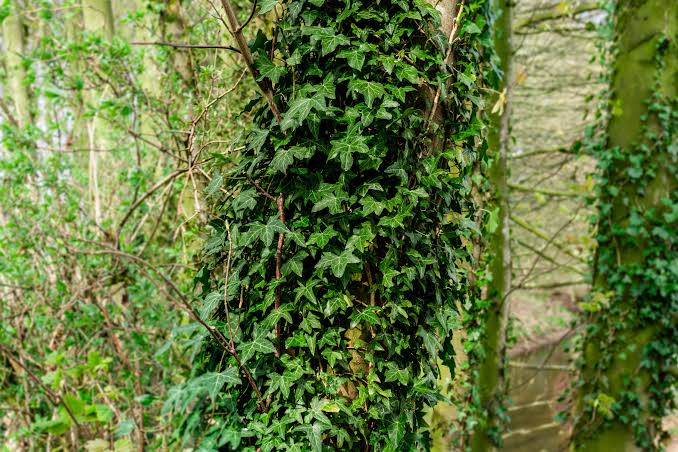
English ivy is a hardy evergreen with dark green, glossy, lobed leaves growing six to eight feet when used as a groundcover. It climbs to fifty feet when used as a vine. The plant climbs and creeps by aboveground roots that cling to most surfaces.
When mature, it creates a lush, green carpet effect. Variegated varieties are also available. In its native environment, the plant is highly valued for attracting wildlife. The flowers and fruits can be eaten and the foliage provides a great retreat for deer and other wildlife.
The plant has also been used as a medicinal treatment for coughs and colds, in addition to bloodshot and watering eyes. However, it contains many toxins, and the leaves can cause a skin irritation or allergic reaction. In late summer, it may produce a small greenish-yellow umbel that is very rich in nectar. In its native habitat the nectar is an important food source for bees and other insects.
After flowering, purplish-black to orange-yellow berries appear. The berries are poisonous to humans, but an important food source for birds. Use it as an understory groundcover in shady conditions for woodsy effects or mix it into containers with taller plants for a cascading effect. The plant is native to Europe, western Asia, and northern Africa.
17. Sweet Potato Vine (Ipomoea batatas)

Sweet potato vine is fast-growing reaching heights of six to twelve inches with a spread of one to three feet. It has dark green or deep purple, heart-shape, lobed leaves. The variety ‘Blackie’ has the darker purple foliage and the variety ‘Margarita’ has green foliage. Both varieties look nice when used together in combinations for their interesting, contrasting, colored foliage.
The plant produces tuberous roots that are similar in appearance to the sweet potato, but they are not edible. Use it in beds, raised planters, window boxes, and hanging baskets; in foundations and borders; trailing or cascading over a wall; or in a container.
Use this groundcover in perennial and annual gardens for it amazing, exotic foliage. This lush groundcover is a great plant for warm seasons and loves our hot, dry weather. It is easy to propagate by cuttings and is easy to transplant. Sweet potato vine is native to the tropical areas of South America.
Also Read: Varieties of Tulip Plant
18. Dusty Miller (Jacobaea maritime)
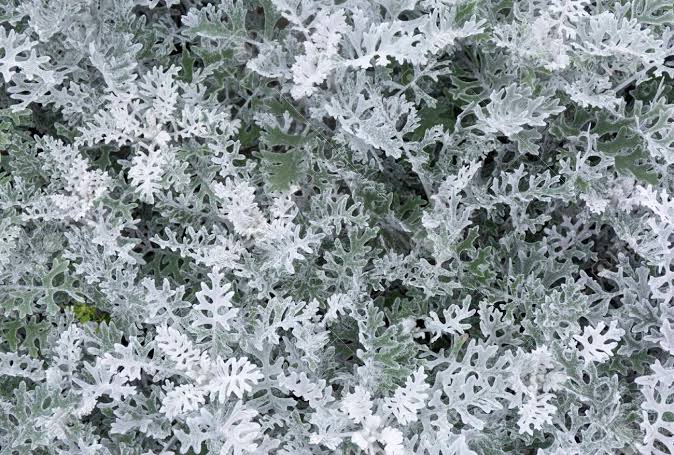
The shrubby perennial grows one to two feet tall and wide in a mounding form. It is known for its silvery-blue, velvety-textured foliage that is intricate and lacey. The stems are covered with long, white, matted hairs. Its foliage provides an attractive contrast to other boldly colored flowering plants. In late summer to early fall, it produces upright flower stalks with mustard yellow spikes.
The flowers are pretty, but the plant is mainly grown for its foliage. There are many varieties available. Rabbits may feed on its foliage but the plant is deer-proof. This plant may be toxic if ingested.
Use it in containers, raised planters, and rock gardens, as edging or a backdrop, or mixed into annual and perennial gardens. The dusty miller is native to the Mediterranean regions of northern Africa, western Asia, and Europe, where it grows in arid locations.
19. Trailing Lantana (Lantana montevidensis)
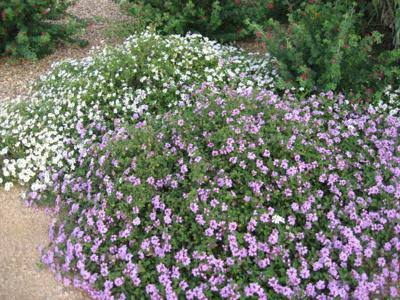
Trailing Lantana is native to South America. Lavender to white colored flowers accent the trailing growth habit of this ground cover. Trailing lantana is immune to desert heat, tolerates almost any soil condition, and is remarkably drought tolerant. It is indeed an excellent plant for spilling over walls or down banks. Eventually, trailing lantana will reach a height of one foot with a four foot spread. The small flowers attract butterflies.
20. Blackfoot Daisy (Melampodium leucanthum)
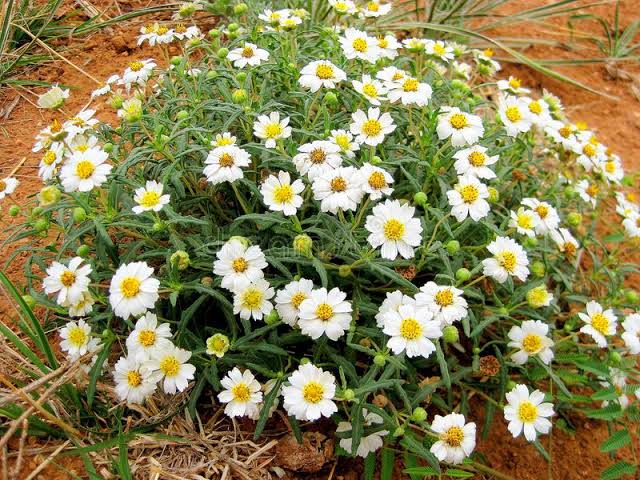
This low-growing plant with aromatic, daisy-like flowers has a mounded appearance with narrow grayish-green foliage. It grows to about one foot tall and eighteen inches wide. Small, abundant, white, daisy-like flowers with a yellow center appear on terminal stalks. The color of this plant can be seen from a distance because of the density of the blooms. Its flowers have a light honey fragrance and attract butterflies and birds.
The plant is also resistant to deer. The perennial produces the most color during the spring and fall seasons. Use it in perennial and wildflower gardens, in masses, or in rock gardens. This plant looks great in the springtime planted next to penstemon and verbena.
The blackfoot daisy is a short-lived specimen groundcover but is worth planting for its color and interesting qualities. It is native to gravelly, dry, desert slopes, rocky soils, pastures, plains, and meadows, and on prairies in Arizona, Texas, New Mexico, Oklahoma, Colorado, and Kansas.
Also Read: Types of Hollyhocks Varieties
21. Prostrate Myoporum (Myoporum parvifolium)

Prostrate myoporum has grass green, narrow leaves evenly spaced in spirals around horizontally spreading stems. It is commonly used as a ground cover. A profusion of small white flowers appear in the spring and continue throughout the summer. This low-growing plant is quite popular here in the low desert.
Myoporum parvifolium will grow fast. The average height is 8 inches. It spreads erratically to 6 feet or more in all directions. Several plants may be grouped to create a continuous ground cover. Prostrate myoporum is frequently used in barren areas, along walkways and walls, or on slopes or banks, where it makes for excellent erosion control.
22. Mexican Evening Primrose (Oenothera speciosa)

The showy, semi-evergreen is admired for its magnificent pink, four-petal, bell-shaped flowers. It spreads in the landscape by underground rhizomes or seed to form extensive colonies growing from eight to twelve inches tall, and spreading to three feet.
The leaves are small and bright green turning crimson to deep red in colder weather. Showy, pink blossoms with yellow veins appear in spring and bloom over a long period. Many insects and moths eat the flower nectar.
This plant is resistant to deer, though the seeds attract birds and other smaller rodents. Varieties are also available with white and yellow flowers. Use it as a mass planting in perennial or rock gardens, for erosion control or as a ground stabilizer.
The plant is native to Texas, southern New Mexico, and Mexico but has naturalized elsewhere in the United States. In its native habitat it grows in open meadows, pastures, hillsides, and slopes, and at the edges of woodland areas.
23. Trailing African Daisy (Osteospermum fruticosum)
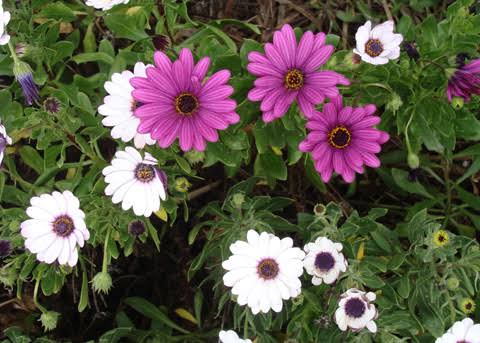
The colorful evergreen with its striking, daisy-like flowers is used to cover large, open areas, spreading by green stems that root into the ground to form a dense carpet of groundcover. The fast-growing plant reaches heights of eighteen inches with long, greenish-blue, fleshy leaves.
It produces large, showy, daisy-like flowers in white, deep purple, and lavender, depending upon the variety. The flowers open during the daylight and close at night and on overcast days. Use it on retaining walls and banks or in borders, raised beds, or containers.
Use it in masses for early spring color. Mix in with spring annuals and perennials as a whimsical accent. This plant will thrive in hot, dry places. The trailing African daisy is native to southern Africa and southwestern Arabia.
Also Read: Types of Hydrangeas For Landscaping
24. Trailing Rosemary (Rosmarinus officinalis ‘prostratus’)
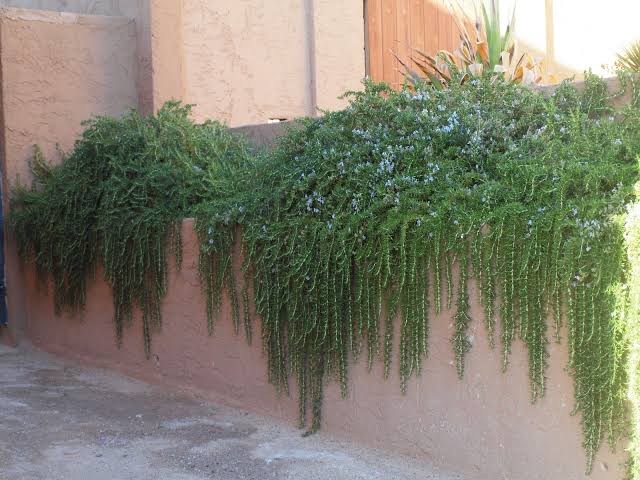
One of the best and toughest ground cover plants for arid regions, Trailing Rosemary does well in nutrient-poor and shallow soils. This plant tolerates great heat and blazing sun as well as cold. Dark green leaves grow to 2 inches long and are rich in aromatic oils.The foliage has a pine-like fragrance. Small, pale blue to white flowers appear along its branches from March to May.
The low-growing, trailing form makes an ideal ground cover. The upright form makes a nice shrub or hedge. Rosmarinus officinalis ‘prostratus’ grows to only about 1 foot high and spreads to 5 feet or wider. In addition to making an excellent ground cover, Trailing Rosemary may be planted in rock gardens, retaining walls or containers.
25. Golden Fleece (Thymophylla pentachaeta)

This low-growing, tufted, herbaceous perennial is a short-lived plant that grows seven inches tall and wide. It re-seeds itself each year during the summer monsoon and re-grows each season with warm weather. The plant has long, threadlike, lacy, bright green foliage with leafless stalks.
It produces bright clusters of yellow, daisy-like flowers on long, slender stems above the foliage. The plant blooms continuously throughout the spring and summer until the first frost, attracting bees, butterflies, and birds. Use it in butterfly and wildflower gardens, containers, raised planters, and rock gardens. The golden dyssodia can also be used for erosion control, on slopes, as an edging plant, and along sidewalks and patios.
This showy groundcover is very easy to propagate from seeds. Allow the seed heads to dry out on the plants and then remove and collect the seed. This plant can also be planted in flats or pot packs and used for quick color. It is native to New Mexico, Arizona, Texas, and northern Mexico, growing in desert areas and rocky plains at elevations of 2,500 to 4,500 feet.
26. Purple Heart (Tradescantia pallid)

This attractive perennial is noted for its violet purple leaves and low-growing habit to one foot with an almost equal spread. The undersides of its narrow, oblong leaves are deep violet to pink. The plant is a vigorous grower with a trailing habit and produces dainty, pink blooms in small clusters that are only open in the morning.
This plant may cause a skin irritation or allergic relation from the juices in its stems. Wear protective clothing and gloves when working around it, especially if you have sensitive skin. Use it for its excellent colored foliage, which makes a nice contrast against other green plants in containers, hanging baskets, rock gardens, raised planters, narrow beds, and borders, and as an understory plant.
This plant is very easy to grow and easy to propagate by cuttings. The Purple Heart is native to tropical and semi tropical areas of Mexico, from Tamaulipas to the Yucatan.
Also Read: Different Types of Viburnum Shrubs
27. Sandpaper Verbena (Verbena rigida)
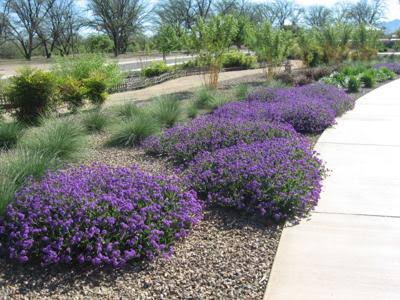
Sandpaper Verbena has large, rough sandpaper-like leaves and stiff, upright branches. Verbena rigida is one of the largest members of the verbena family, growing to 2 feet tall by 4 feet wide. It is very hardy and long-lived. Sandpaper verbena is used for edging or as a ground cover.
The foliage mass may become as high as 3 feet. Ruffled, purple colored flowers appear in the spring and remain through the summer months. Flower color ranges from lavender to light-purple. Sandpaper verbena plants can be grouped together to form a continuous ground cover and used on banks or slopes for erosion control.
28. Periwinkle (Vinca major)
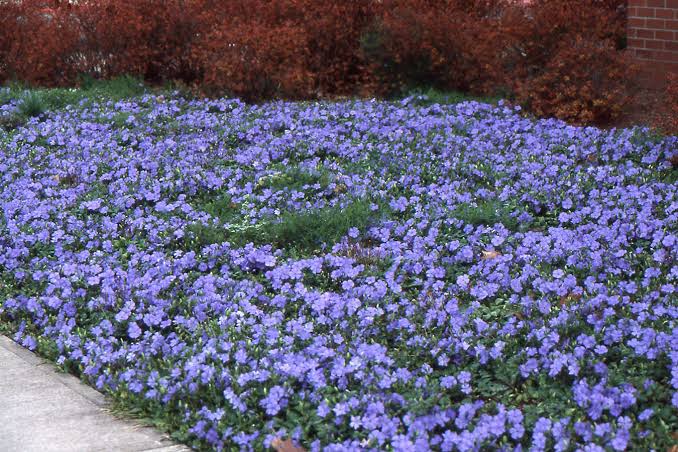
The low-growing evergreen spreads and roots along the ground with its trailing, arching stems, forming a dense mat. It has dark glossy green, slightly hairy foliage with pointed tips. In early spring, it produces purplish-blue, star-like, funnel-shaped blossoms.
The variety ‘Alba’ has white flowers, and many other varieties are available. This lush plant needs an ample amount of water to look good, but will tolerate deep, periodic irrigation. It will wilt if it becomes water-stressed.
This ground cover likes to be planted in rich, well-draining soil. Periwinkle will show foliage damage at temperatures below fifteen degrees Fahrenheit, but recovers quickly if frosted back. It tolerates full sun, but looks best planted in filtered sun in the Southwest desert. It may become invasive with its greedy roots and is difficult to eradicate. All parts of this plant are poisonous if ingested.
Use it as a bank cover, in containers, window boxes, and planters and as an understory plant for woodsy effects. Use periwinkle for erosion control, as filler for bare areas, or mixed into rock gardens. Try the variety ‘Variegata’ for its variegated leaves with yellowish-white leaf margins. The species is native to southern Europe, central Asia, and northern Africa.
29. Sweet Violet (Viola odorata)
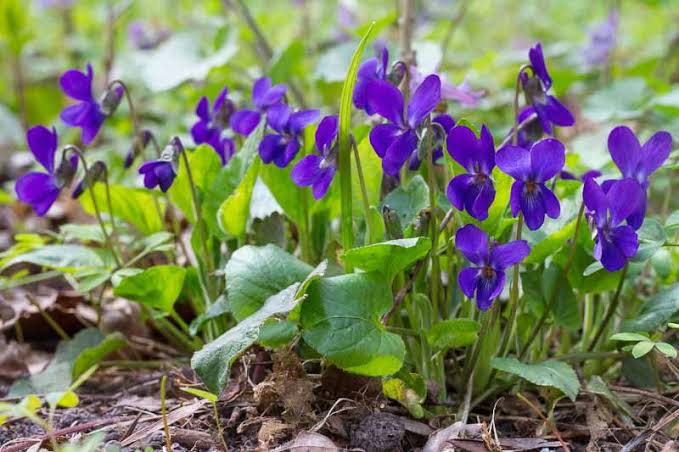
The fast-growing, long-lived evergreen reaches four inches tall with aromatic, violet flowers and small, heart-shaped foliage that is slightly serrated and dark green in color. It grows in a rosette with creeping runners that root and spread.
The plant produces fragrant, five-petal flowers in deep purple, blue, violet, lavender, pink, or white, depending on variety. The flowers are edible and last from late winter through late spring. Historically, both the flowers and foliage have provided medicinal benefits and have been used to treat respiratory problems and other ailments. The flowers can also be used to decorate salads and deserts. The ancient Greeks used the violet as a symbol of love and fertility. It was also used in love potions.
Sweet violet goes dormant during the hot weather, but looks beautiful other times of the year. It likes partial shade to light shade conditions. Give it regular irrigation but do not over-water. This plant is hardy into the low twenties Fahrenheit, and prefers rich, well-draining soil and good fertilization in the spring. Sweet violet spreads quickly by short runners or can be propagated by seeds.
Use it for color or a woodsy effect under the shade of a tree, as a border plant, and in planters and containers. It is native to Europe, Asia, and Africa and has naturalized all over the world.
Further References
- Evergreen Ground Covers: https://savvygardening.com/evergreen-groundcover/
- Best Plants For Ground Cover: https://www.businessdailyafrica.com/bd/lifestyle/the-best-plants-for-ground-cover–2086126
- Low maintenance ground covers: https://www.thespruce.com/best-low-maintenance-ground-covers-4125117
- Great Ground Covers: https://www.countryliving.com/gardening/garden-ideas/how-to/g789/ground-cover-flowers-0509/
- Native Ground Covers: https://sonomamg.ucanr.edu/California_Natives/Native_Groundcovers/
- Keator, Glenn, Complete Garden Guide to the Native Perennials of California, 1990.
- Keator, Glenn, Complete Garden Guide to the Native Shrubs of California, 1994.
- Bornstein, Fross, O’Brien, California Native Plants for the Garden, 2005.